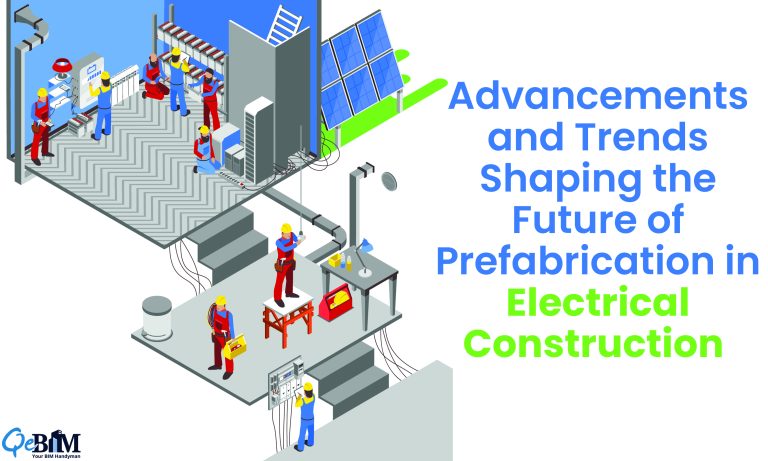Advancements and Trends Shaping the Future of Prefabrication in Electrical Construction

The construction industry has recently witnessed a significant shift towards efficiency, sustainability, and cost-effectiveness. Prefabrication is the process of constructing components off-site and assembling them on-site with the help of accurate Fabrication Drawing Services, which has emerged as a game-changer in the construction sector. This trend is not limited to just general construction; it has also made its mark in the electrical construction industry. Prefabrication in electrical construction offers numerous advantages, including reduced labor costs, improved project timelines, and enhanced quality control. In this blog, we will explore and analyze the future of prefabrication in electrical construction, highlighting the advancements and trends shaping the industry.
Advancements in Prefabrication Techniques
1) Building Information Modeling (BIM):
BIM technology has revolutionized the construction industry and continues to play a vital role in the future of prefabrication. BIM allows for detailed 3D modeling of electrical systems, enabling better coordination between various trades and minimizing clashes during installation. Prefabrication companies can leverage BIM to optimize the design and fabrication process, resulting in increased accuracy and reduced rework.
2) Modularization:
Modularization involves creating pre-assembled electrical components in a controlled factory environment. These components are then supplied to the construction site for quick and efficient installation with detailed and explicit Electrical Shop Drawing Services. The advancements in modularization techniques, such as advanced robotics and automated assembly lines, have significantly improved the quality and speed of electrical construction projects. Modularization also allows for better standardization, making it easier to replicate successful projects and streamline the construction process.
3) Off-Site Manufacturing:
Off-site manufacturing, also known as off-site construction, involves fabricating entire building modules in a factory setting. This approach has gained immense popularity due to its ability to reduce construction time, minimize on-site disruption, and improve safety. In electrical construction, off-site manufacturing allows for assembling complex electrical systems within controlled factory conditions, ensuring higher quality and reducing the risk of errors.
4) Prefabricated Electrical Systems:
Prefabricated electrical systems, including pre-wired panels, modular power distribution units, and pre-assembled conduit systems, are becoming increasingly prevalent in the industry. These systems are produced at different sites and delivered as complete units, ready for installation. Prefabricated electrical systems reduce on-site labor requirements, minimize the risk of errors, and accelerate project timelines. They also facilitate efficient system integration and allow for easier maintenance and future expansions.
Trends Shaping the Future
- Sustainability and Energy Efficiency:
As the world focuses on sustainability and reducing carbon footprints, the electrical construction industry aligns itself with these goals. Prefabrication enables better control over energy usage and promotes the integration of energy-efficient systems. With off-site manufacturing, manufacturers can incorporate sustainable materials and technologies into their products, such as solar panels, energy storage systems, and smart grid solutions.
- Integration of Smart Technologies:
The rise of smart buildings and the Internet of Things (IoT) has profoundly impacted the electrical construction sector. Prefabrication allows for the seamless integration of smart technologies, including sensors, controls, and automation systems. By incorporating these technologies during off-site manufacturing, electrical systems can be designed and optimized for intelligent operation, resulting in increased energy efficiency, improved occupant comfort, and enhanced building performance.
- 3D Printing:
3D Printing holds the strong potential to revolutionize prefabrication in electrical construction. This technology can produce complex electrical components and even entire buildings with precision and speed. 3D Printing allows for any level of customization, reduced material wastage, and the possibility to create intricate designs that were previously challenging to accomplish and execute. As the technology matures, we can definitely expect to see more of 3D Printing implementation in electrical construction.
- Collaboration and Information Sharing:
Collaboration among the stakeholders and teams involved in the construction process is critical for the success of prefabrication projects. With the advancements in cloud-based collaboration tools, real-time information sharing and coordination between architects, engineers, contractors, and prefabrication companies have become more accessible. These tools facilitate seamless communication, reduce errors, and enable better project management, ultimately improving efficiency and productivity.
Conclusion
The future of prefabrication in electrical construction looks promising, driven by technological advancements and the industry’s evolving needs. Building Information Modeling, modularization, off-site manufacturing, and prefabricated electrical systems transform how electrical construction projects are planned and executed. The key trends shaping the industry are sustainability, smart technologies, 3D Printing, and enhanced collaboration. As prefabrication continues to gain momentum, electrical construction projects will become more efficient, cost-effective, and environmentally friendly, leading to a brighter and more sustainable future for the construction industry as a whole.